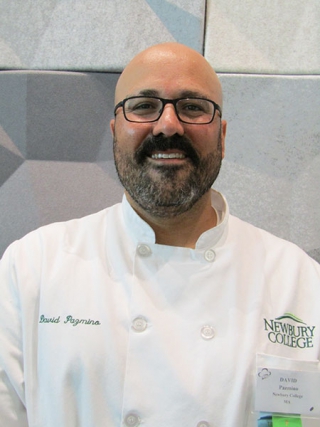
Technology in the Kitchen
26 January 2018How the technology of QR codes unlocked the power of smartphones in the classroom.
By Chef David Pazmiño of Newbury College
“People who do not accept the new, grow old very quickly.”
Auguste Escoffier
It took me years to realize the legacy that Auguste Escoffier left all of us in the culinary field. This newfound reverence wasn’t for the vast repository of information or for carving out what most students learn as the 5-Mother Sauces and the brigade system. It’s not for the hours spent gleaning information about cooking techniques and obscure French cooking terms. It was for his unrelenting drive for change and willingness to confront what was considered established norms and protocols in the kitchen. The publication of a tome with all the “trade secrets” wasn’t looked upon with open arms as we see it today. Escoffier was and still is a “provocateur extraordinaire”.
It has been a long path to come to this realization. I have often told the story about one of my students years ago that refused to remove her facial piercings -- a real “punk rocker” through and through -- despite all our rules forbidding them. But a light went off for this student in one of the most unforeseen places: a lesson in garde manger class on how to open an oyster. This student went on to not only run an oyster station at a very popular restaurant, but she started competing in oyster shucking competitions and was headhunted merely for her oyster shucking prowess (without any regard to her facial jewelry). What was this “provocateur” trying to teach me? How could the rigidity of my culinary teaching be altered to better appeal to the sensibilities of all students?
When approaching the concept of technology, I take the “provocateur” Escoffier to heart: “People who do not accept the new, grow old very quickly.” How would he approach the issue of technology in the kitchen? Would we simply be following the written prescriptions that he outlined over a 100-years ago, or should we be pushing the envelope of cooking and learning? How would he be challenging the “how” and “why” of cooking?
These are the questions I ask myself when thinking about how I can use technology effectively in the classroom as a tool rather than a gimmick. How can I push the envelope of learning yet still maintain an orientation toward the base set of knowledge needed for entering the culinary profession? Probably the most powerful technological tool we have in all of our kitchens is the smartphone. For many instructors, it is the bane of our daily teaching regimen -- telling people to get off their phones, stop texting, stop using social media. And believe me, they know all the right places in the kitchen to duck and hide to check their phones.
But then Monsieur Escoffier jumps in my head -- accept the new. Over the last couple of years I have been trying to use the smartphone as a tool, a powerful tool that all of my students carry with them each and every day. But I didn’t want these devices to just do mathematical calculations or take pictures. I wanted to use them to engage students and assist them in learning. It was also at the same time that all classes, including culinary classes, were required to use our school’s online learning management systems. I was motivated to go to a paperless classroom model.
Simultaneously, we had a Boston chef, Jose Duarte, visit the school for a demonstration. He was using silk screens and squid ink to transfer QR codes to dinner plates so customers could take out their phones, scan the code from the plate, and receive information about the fisherman and the origin of the seafood. The students in the classroom all left excited. That got me thinking: How could I use QR codes in the classroom?
And like most things, other secondary school instructors had been doing the same thing -- creating QR codes to direct students to videos, articles, PDF downloads, and Google Docs documents. My head started spinning in terms of the possibilities. I can now create a recipe or formula in Google Docs, copy the shared link, paste that link into a QR Generator, download the QR code, and then print it out. I could then tape the printed QR code to student stations or on the whiteboard for students to scan with their smart phones. They then would have a direct link to the information I want them to have!
One of the ways I have been using this lately is for quizzes as well as for the wrap at the end of the day. I will use Google Forms to create a quiz or a series of questions I want them to answer. After creating the form, I copy the link and create a QR code for that link. To help fill up time during the cleaning process at the end of class, I ask students to scan a QR that links to a series of reflective questions and ask students to answer them with any leftover class time. It is part of the common “whip” -- what have you learned today? I can then pull up all the responses and review it before dismissal.
While there is no right or wrong answer on how to use technology in the culinary kitchen, the willingness to embrace the “new” and to find ways to integrate it into already established norms pushes the envelope of teaching and learning.
